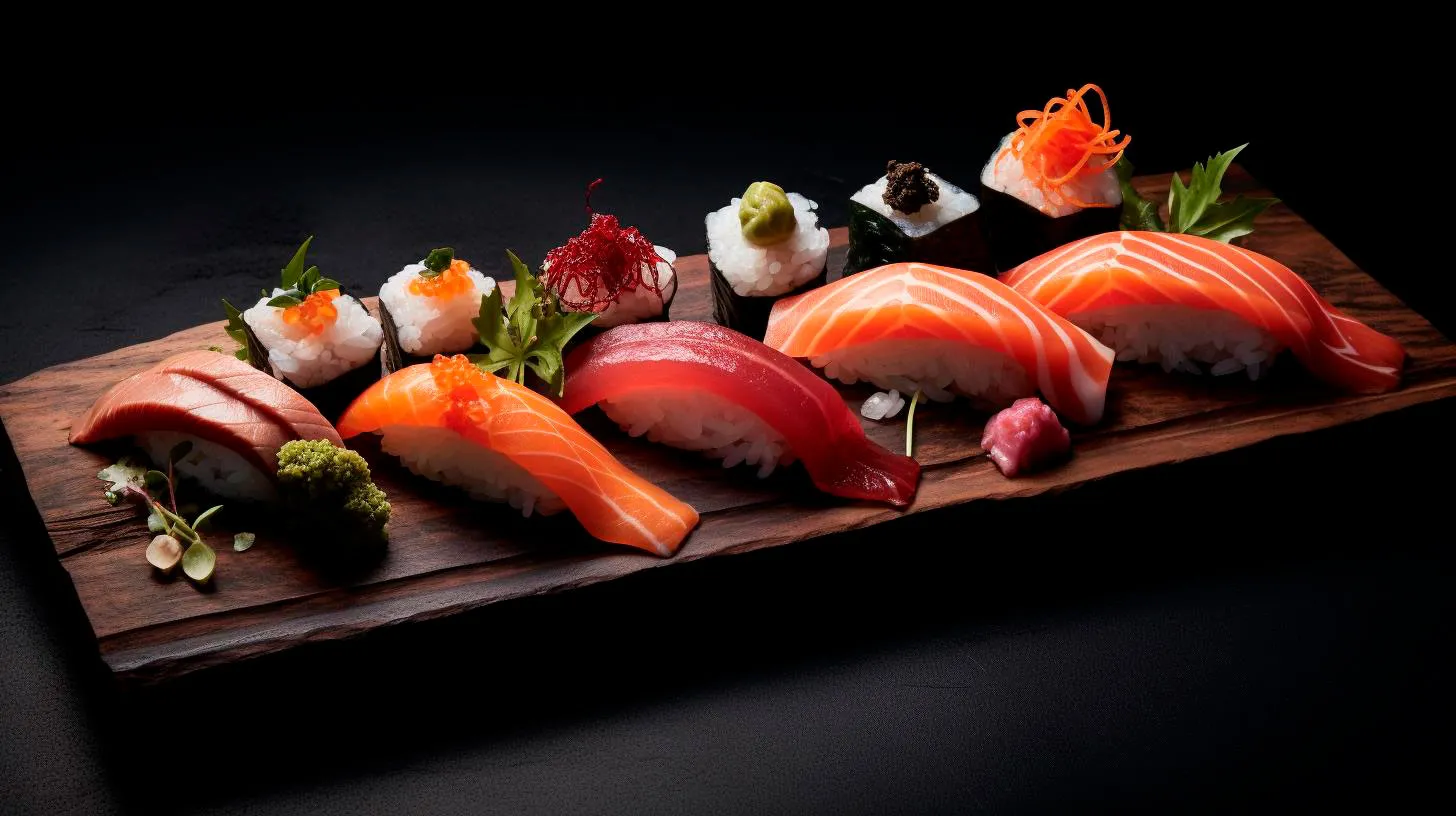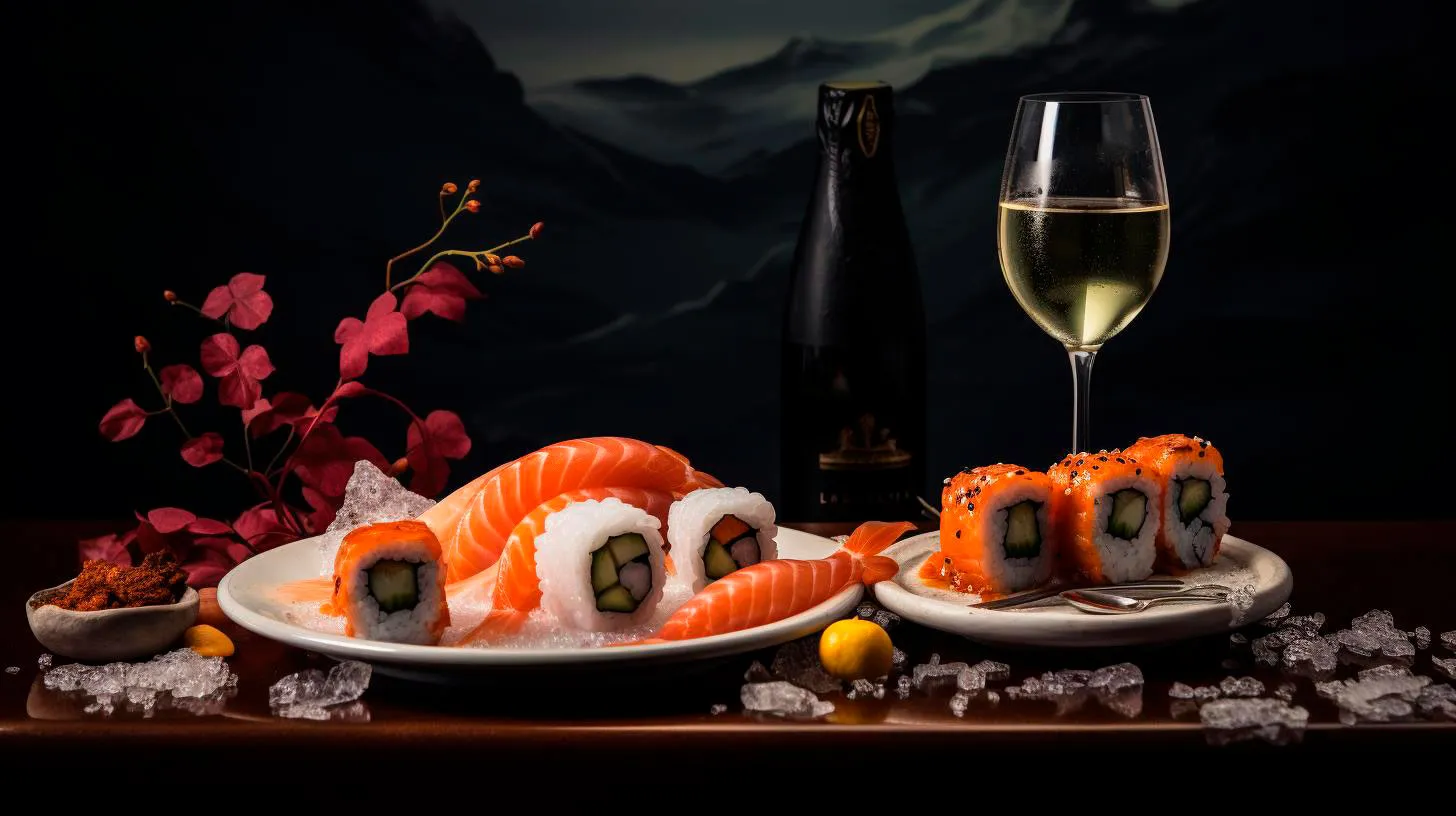The Art of Sushi: A Delicious Reflection of Japanese Culture
From the meticulous preparation to the presentation, every aspect of sushi reflects the Japanese dedication to perfection and harmony.
A Cultural Icon
Sushi has evolved over centuries and has become an essential part of Japanese culture. It is deeply intertwined with the Japanese way of life and holds a special place in their hearts. Here are a few key aspects that make sushi a cultural icon:
- Precision and Attention to Detail: Sushi making is an art that demands precision and meticulousness. From selecting the freshest ingredients to the intricate knife skills required to cut the fish, every step in the sushi-making process is executed with utmost care.
- Seasonality: Sushi is deeply rooted in the appreciation of seasonal ingredients. Traditional sushi chefs meticulously select ingredients that are at their peak, capturing the essence of each season on a plate.
- Presentation: Sushi’s visual appeal is undeniable. It is carefully arranged, showcasing the beauty of its ingredients and colors. Sushi chefs create edible works of art that satisfy not only the taste buds but also the eyes.
- Dining Etiquette: Sushi etiquette is an integral part of the Japanese dining experience. From using chopsticks correctly to knowing the proper way to dip sushi in soy sauce, following these customs demonstrates respect for the sushi chef’s craft.
Innovation and Evolution
While sushi has strong roots in tradition, it has also embraced innovation and adapted to cater to changing tastes. As the popularity of sushi spread globally, chefs began experimenting with new flavors and creative combinations. This led to the birth of various sushi styles like fusion sushi and rolls with non-traditional ingredients.
Here are a few sushi innovations that have become popular:
- California Roll: This iconic roll, created in the 1960s, introduced avocado and imitation crab as ingredients, appealing to a broader audience who may be hesitant to try raw fish.
- Sushi Burrito: The fusion of sushi and burrito brought forth a new trend. These oversized rolls offer a convenient and portable way to enjoy sushi, making it accessible to those on the go.
- Vegan and Vegetarian Sushi: Recognizing dietary preferences and restrictions, sushi chefs have embraced the need for plant-based options. Creative combinations of vegetables, tofu, and unique sauces have given rise to an array of vegan and vegetarian sushi rolls.
Health Benefits
Sushi not only stimulates the palate, but it also offers several health benefits. Let’s take a look at some of them:
- Omega-3 Fatty Acids: Fish, a staple in sushi, is an excellent source of omega-3 fatty acids, which are known to promote heart health and reduce the risk of cardiovascular diseases.
- Low in Calories: Sushi rolls have relatively low calorie counts compared to other options such as fast food or fried snacks. It is a healthier alternative that satisfies hunger without excessive calorie intake.
- Rich in Nutrients: Sushi typically includes a variety of vegetables, seaweed, and fish, providing a range of vitamins, minerals, and antioxidants necessary for a balanced diet.
- Food Safety: Strict food safety measures are followed in sushi preparation, ensuring the freshness and quality of ingredients.
A Culinary Journey
Embarking on a sushi journey allows you to experience the cultural richness of Japan. Here are some key takeaways to remember:
- Respect Tradition: Understand and appreciate the craftsmanship, precision, and traditions that sushi embodies.
- Try New Flavors: Don’t be afraid to venture beyond your comfort zone and explore the diverse range of sushi options available.
- Embrace Sushi Etiquette: Familiarize yourself with sushi etiquette to ensure a respectful and enjoyable dining experience.
- Indulge Mindfully: While sushi is delicious, it’s important to consume it in moderation and savor each bite mindfully.
Sushi is more than just a culinary delight; it encapsulates the Japanese way of life. Embracing the art of sushi allows us to experience the cultural depth, precision, and harmony of Japan on our plates.
Unveiling the Hidden Meanings in Japanese Art: Sushi and Samurai
Prepare to uncover the hidden meanings behind their artistic representations and the fascinating stories they tell.
The Art of Sushi
Sushi, the delectable Japanese culinary delight, is not just a masterpiece on your plate but also an art form. From the careful selection of ingredients to the precise technique of rolling and shaping, every step in creating sushi is infused with artistic intention. The following are some key elements that make sushi a unique representation of Japanese art:
- Simplicity is Key: In the art of sushi, simplicity reigns supreme. The minimalist approach to presentation showcases the natural beauty of the ingredients used. The vibrant colors of fresh fish, carefully selected vegetables, and perfectly seasoned rice create a harmonious visual symphony.
- The Balance of Elements: Just like brushstrokes on a canvas, sushi embodies balance. Traditional sushi consists of rice, fish, and seaweed, each representing one of the three primary elements: earth, water, and fire. This symbolic representation brings harmony and balance to the dish.
- Seasonality and Harmony with Nature: Japanese art often emphasizes the connection between humans and nature. Sushi follows the same principle by embracing seasonality. The use of seasonal ingredients not only ensures the freshest flavors but also reflects the ever-changing beauty of nature.
The art of sushi transcends its visual appeal and traditional significance. It represents Japan’s deep-rooted cultural values, such as simplicity, balance, and harmony with nature.
The Powerful Symbolism of the Samurai
The samurai, the iconic warriors of feudal Japan, are a symbol of strength, discipline, and honor. The depiction of samurai in Japanese art carries rich symbolism that extends beyond their physical appearance. Let’s explore some of the hidden meanings behind the artistic representations:
- Bushido: The Way of the Samurai: The concept of Bushido, the code of the samurai, serves as the foundation for their representation in art. Artistic portrayals often highlight the seven virtues of Bushido, including honor, integrity, and loyalty. These virtues inspire artists to capture the essence of the samurai’s dedication to their path.
- The Symbolism of Armor: Samurai armor, known as “yoroi,” is not just a protective gear but a symbol of status and power. Each piece of armor is meticulously crafted and decorated, reflecting the warrior’s accomplishments and position in society. The intricate designs and motifs tell tales of bravery and heraldic significance.
- Cherry Blossoms and Transience of Life: In Japanese art, cherry blossoms symbolize the beauty and fleeting nature of life. Many samurai-themed artworks feature cherry blossoms as a reminder of the impermanence of existence and the samurai’s acceptance of their mortality.
Through the symbolism and artistry employed in the depiction of samurai, Japanese artists convey the essence of the warrior spirit and the deep-rooted values that define the samurai’s way of life.
Key Takeaways
As we unveil the hidden meanings in Japanese art, we gain valuable insights into the culture and values of Japan. Here are the key takeaways from our exploration:
- The art of sushi reflects Japanese cultural values of simplicity, balance, and harmony with nature.
- The samurai’s representation in art showcases their adherence to the code of Bushido, their armor symbolizing power and status, and cherry blossoms symbolizing the transience of life.
- Japanese art speaks volumes about the rich history, traditions, and values deeply intertwined with the nation’s identity.
So, the next time you enjoy a plate of sushi or admire a samurai artwork, remember the hidden meanings they hold and let their captivating stories transport you to the fascinating world of Japanese art.
Exploring the Spiritual Symbolism in Samurai Warrior Art
The History and Origins
The samurai class emerged during medieval Japan and lasted until the 19th century. They were not only skilled warriors, but also staunch followers of the Bushido code – a strict ethical framework guiding their actions. Becoming a samurai was much more than joining an elite fighting force; it was a lifelong commitment to embracing honor, loyalty, and discipline.
Samurai warrior art, through its intricate designs and symbolism, sought to capture the essence of these noble warriors and their deeply held spiritual beliefs. Let’s delve into some of the key symbols found in this art form:
1. Cherry Blossoms
Cherry blossoms are often depicted in samurai warrior art due to their ephemeral nature. The short-lived blossoms symbolize the passing of time, reminding warriors to seize the present moment and embrace life’s transience. It serves as a powerful reminder that life, just like the fragile beauty of cherry blossoms, is fleeting.
Key Takeaway: Embrace the present moment and cherish the beauty of life’s fleeting nature.
2. Dragons
Dragons hold significant cultural and symbolic importance in Japan. In samurai warrior art, dragons are often portrayed as powerful and mythical creatures. They represent wisdom, strength, and protection. The samurai aspired to emulate these qualities in their battles and daily lives, seeking to become noble defenders of their land and people.
Key Takeaway: Embrace inner strength, wisdom, and honorable defense of what you hold dear.
3. Mount Fuji
Mount Fuji, Japan’s iconic and sacred mountain, is a prominent symbol in samurai warrior art. Depicting this majestic peak represents not only the physical terrain that shaped Japan but also the spiritual connection between nature and warriors. Mount Fuji’s towering presence embodies the resilience and unwavering spirit that samurai warriors sought to instill within themselves.
Key Takeaway: Strive for resilience and an unwavering spirit in the face of challenges.
The Significance in Modern Times
While the samurai era has long passed, the symbolism found in their art continues to captivate and inspire people to this day. The virtues and principles embodied in samurai warrior art hold valuable lessons for modern society:
1. Cultivating Mindfulness and Presence
By highlighting the fleeting nature of life, samurai warrior art urges us to become more mindful of the present moment. In a world characterized by constant distractions, taking a page from the samurai’s book can bring a fresh perspective and help us appreciate the beauty and significance of each passing moment.
2. Embracing Strength and Wisdom
The dragon symbolizes the inner strength and wisdom that lies within each one of us. By drawing inspiration from these mystical creatures, we can find the courage to overcome obstacles and strive for personal growth. Embracing the qualities of the dragon allows us to tap into our innate power and unleash our full potential.
3. Connecting with Nature
In an increasingly urbanized world, reconnecting with nature has become more important than ever. Mount Fuji’s representation in samurai warrior art reminds us of the significant role nature plays in our lives. It encourages us to respect and protect the natural world, fostering a deeper appreciation for the environment and our place within it.
In Conclusion
Samurai warrior art is not confined to a historical period but continues to inspire and enlighten us today. Through its symbolic representation, it captures the indomitable spirit and wisdom of the samurai. By embracing the lessons embedded within this captivating art form, we can strive for personal growth, find strength in adversity, and foster a deeper connection with the world around us.
From the Plate to the Canvas: The Interplay between Sushi and Samurai Art
The Artistry of Sushi and Samurai
Sushi, with its delicate combination of flavors and textures, is a culinary art form that requires precision and attention to detail. Similarly, the samurai warriors practiced martial arts as an art form, combining discipline, skill, and grace. The artistry found in both sushi and samurai can be seen not only in the end result but also in the process.
- Sushi chefs train for years to perfect their craft, honing their skills in the art of knife work, rice preparation, and ingredient selection.
- Samurai warriors devoted their lives to mastering martial arts, studying various techniques, and understanding the philosophies behind the art of combat.
Both sushi chefs and samurai warriors exhibited a level of dedication and craftsmanship that can only be described as art.
Symbolism and the Way of the Warrior
In Japanese culture, symbolism plays a significant role. Both sushi and samurai art are deeply rooted in symbolism, showcasing the traditions and beliefs of ancient Japan.
Sushi, with its emphasis on fresh and seasonal ingredients, reflects the harmony between nature and humanity. Each sushi roll tells a story, often representing the beauty of the changing seasons or regional specialties. Just as sushi artfully portrays the natural world, samurai art depicts the ideals and values of the warrior class.
- Samurai armor adorned with intricate designs and symbols offered protection while reflecting the status and honor of the wearer.
- Paintings and calligraphy featuring samurai warriors often conveyed abstract concepts such as bravery, loyalty, and self-discipline.
Through their art forms, both sushi and samurai encapsulate the essence of Japanese aesthetics and philosophy.
The Influence of Samurai Art on Sushi Presentation
The influence of samurai art can be seen in the presentation of sushi. Traditional sushi counters often incorporate elements reminiscent of the samurai era, creating an immersive experience for diners.
- Sushi bars may feature wooden counters with elegant craftsmanship, alluding to the craftsmanship found in samurai swords.
- Serving plates and bowls may feature intricate designs similar to those found on samurai armor, adding a touch of historical significance to the dining experience.
By infusing samurai art into sushi presentation, sushi chefs pay homage to Japan’s rich history and create a remarkable visual experience for their customers.
Key Takeaways
The interplay between sushi and samurai art highlights the deep connection between these two iconic elements of Japanese culture. Here are the key takeaways:
- Sushi and samurai art are both defined by their artistry, precision, and attention to detail.
- Symbolism plays a significant role in both sushi and samurai art, reflecting the traditions and beliefs of ancient Japan.
- The influence of samurai art can be seen in the presentation of sushi, creating a unique and immersive dining experience.
From the plate to the canvas, sushi and samurai art embody the rich history, traditions, and aesthetics of Japan. Exploring the interplay between these cultural icons allows us to deepen our understanding of Japanese art and appreciate the beauty found in both the culinary and martial arts.


